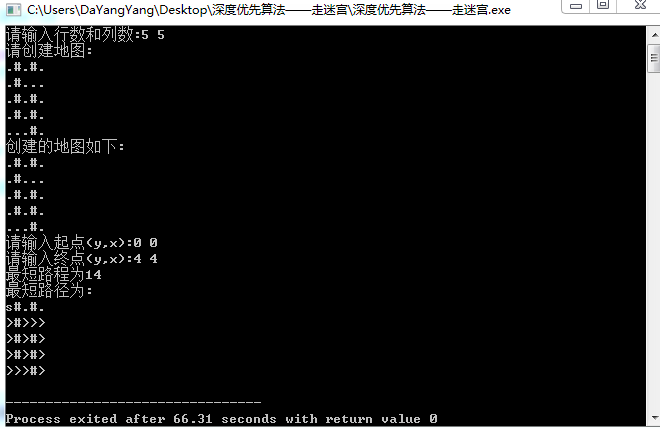深度优先算法——走迷宫的实现
深度优先搜索 算法(Depth-First-Search),是搜索算法的一种。是沿着树的深度遍历树的 节点 ,尽可能深的搜索树的分支。当节点v的所有边都己被探寻过,搜索将回溯到发现节点v的那条边的起始节点。这一过程一直进行到已发现从源节点可达的所有节点为止。如果还存在未被发现的节点,则选择其中一个作为源节点并重复以上过程,整个进程反复进行直到所有节点都被访问为止。属于 盲目搜索 。
深度优先搜索是图论中的经典算法,利用深度优先搜索算法可以产生目标图的相应拓扑排序表,利用拓扑排序表可以方便的解决很多相关的图论问题,如最大路径问题等等。
因发明“深度优先搜索算法”,霍普克洛夫特与陶尔扬共同获得计算机领域的最高奖:图灵奖.
学以致用,为了在实践中学习,我用深度优先算法写了一个走迷宫的小程序。
具体内容为:
1、输入长宽和迷宫地图(‘#’代表墙,‘.'代表空地)
2、输入起点和终点坐标
3、用深度优先算法查找起点到终点的最短路径并显示出来
下面是具体C语言实现:
1 #include <stdio.h> 2 3 char map[50][51]; //地图上限50*50 4 int sign[50][50]; //标记 5 int next[4][2]={{0,1},{1,0},{0,-1},{-1,0}}; 6 int n,m; //实际地图行数、列数 7 int endy,endx; //终点位置 8 int min=99999999; 9 10 /* run this program using the console pauser or add your own getch, system("pause") or input loop */ 11 12 //构造一个盏来记录走迷宫的路径 13 struct Node 14 { 15 int y; 16 int x; 17 }; 18 19 struct Stack 20 { 21 Node * pbase; 22 int top; 23 }; 24 25 void StackInit(Stack * pstack){ 26 pstack->pbase=new Node[100]; 27 pstack->top=0; 28 } 29 30 void StackPush(Stack * pstack,int y,int x){ 31 Node node; 32 node.y=y; 33 node.x=x; 34 pstack->pbase[pstack->top]=node; 35 ++pstack->top; 36 } 37 38 void StackCopy(Stack * pstack1,Stack * pstack2){ 39 pstack2->top=pstack1->top; 40 for(int i=0;i<pstack2->top;i++) 41 { 42 pstack2->pbase[i]=pstack1->pbase[i]; 43 } 44 } 45 46 void StackPop(Stack * pstack){ 47 --pstack->top; 48 } 49 50 Stack stack; 51 Stack minstack; 52 53 //深度优先搜索 54 void dfs(int y,int x,int step){ 55 int ty,tx; 56 if(y==endy&&x==endx) 57 { 58 if(step<min) 59 { 60 StackCopy(&stack,&minstack); 61 min=step; 62 } 63 return; 64 } 65 66 for(int i=0;i<4;i++) 67 { 68 ty=y+next[i][0]; 69 tx=x+next[i][1]; 70 if(ty>=0&&ty<n&&tx>=0&&tx<m&↦[ty][tx]!='#'&&sign[ty][tx]==0) 71 { 72 StackPush(&stack,ty,tx); 73 sign[ty][tx]=1; 74 dfs(ty,tx,step+1); 75 StackPop(&stack); 76 sign[ty][tx]=0; 77 } 78 } 79 return; 80 } 81 82 int main(int argc, char** argv) { 83 printf("请输入行数和列数:"); 84 scanf("%d%d",&n,&m); 85 printf("请创建地图:/n"); 86 for(int i=0;i<n;i++) 87 { 88 scanf("%s",↦[i]); 89 } 90 printf("创建的地图如下:/n"); 91 for(int i=0;i<n;i++) 92 { 93 printf("%s/n",map[i]); 94 } 95 printf("请输入起点(y,x):"); 96 int starty,startx; 97 scanf("%d%d",&starty,&startx); 98 printf("请输入终点(y,x):"); 99 scanf("%d%d",&endy,&endx); 100 sign[starty][startx]=1; 101 102 StackInit(&stack); 103 StackInit(&minstack); 104 105 dfs(starty,startx,0); 106 printf("最短路程为%d/n",min); 107 108 printf("最短路径为:/n"); 109 map[starty][startx]='s'; //用字符's'表示起点 110 for(int i=0;i<minstack.top;i++) 111 { 112 map[minstack.pbase[i].y][minstack.pbase[i].x]='>'; 113 } 114 for(int i=0;i<n;i++) 115 { 116 printf("%s/n",map[i]); 117 } 118 return 0; 119 } 运行结果如图(’>'表示最短路径,'s'表示起点)

正文到此结束
热门推荐
相关文章
Loading...











![[HBLOG]公众号](https://www.liuhaihua.cn/img/qrcode_gzh.jpg)

